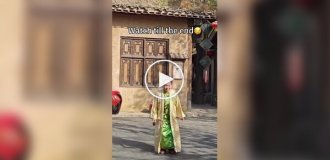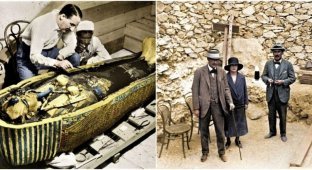It was a mistake to open it up. What riddle did the most mysterious pharaoh leave (6 photos)
Scientists have determined the cause of death of the discoverers of Tutankhamun's tomb 
Exactly one hundred years ago, British archaeologists opened the sarcophagus of Tutankhamun. The grandiose scientific event was followed by a trail of mysticism known as the “curse of the pharaoh.” But scientists explained what was going on.
The game was worth the candle
"Do you see anything there? - Oh yes, amazing things. Too good to be true." This short dialogue took place on November 26, 1922. However, any words were unnecessary. Things spoke for themselves. On that day, the tomb of Tutankhamun was revealed to the world.
The British amateur explorer Howard Carter had the idea to find it at the beginning of the century. The First World War intervened. And there were no sponsors. They say there is nothing to look for in the Valley of the Kings - everything has been explored far and wide.
One was still found. The British rich man and collector of antiquities George Herbert, Earl of Carnarvon, provided funds. But months passed, and there was no news from the archaeologist.
Imagine the tycoon’s amazement when, on November 6, he received a telegram from Luxor: “Finally, they made an amazing discovery in the valley: a magnificent tomb with intact seals; we are waiting for your arrival.”
Carter's workers cleared an area that was once an Egyptian construction village. Nothing interesting. But the researcher decided that it was still worth digging here. And I was right. 
Howard Carter
Under the remains of one of the huts a massive stone step appeared, followed by a second, and a third. An underground corridor led to a plastered wall with seals. The jackal and nine bows are royal signs.
After making a small hole, Carter looked inside. Gold sparkled in the dim light of the kerosene lamp. "Too good to be true."
“When my eyes adjusted to the light, the details of the room slowly emerged through the haze. Strange animals, statues and vessels - a reflection of gold everywhere,” the archaeologist recalled.
A luxurious chariot, a royal throne, vases, several chests, and many valuable artifacts. And a door with the inscription "Nebkheprura". Tomb. 
Luxor, Valley of the Kings
Retribution for what was done
Carter opened it alone on January 3, 1924. Lord Carnarvon had died unexpectedly a year earlier. According to the official version - from blood poisoning: he accidentally cut himself with a razor at the site of a mosquito bite.
The English writer Maria Corelli had a different opinion. “The most severe punishment awaits the intruder who enters the tomb,” she explained.
Sir Arthur Conan Doyle was not only the author of detective stories about Sherlock Holmes, but also a famous spiritualist and lover of all things mysterious. In his opinion, Carnarvon was killed by certain “elementals” created by the priests to guard the tomb.
An inscription, supposedly carved on the wall of the crypt, circulated across the pages of newspapers: “Those who enter this sacred tomb will soon be visited by the wings of death.” 
Howard Carter and Arthur Mays open the entrance to Tutankhamun's tomb
Carter was outraged by this. “The feeling of an Egyptologist <...> is not a feeling of fear, but of respect and awe, <...> completely opposite to stupid superstitions,” he said.
However, over the next five years, several more people involved in the discovery died under strange circumstances.
The Egyptian prince Ali Kamel Fahmy Bey passed away in 1923, the radiologist Sir Archibald Douglas-Reid in 1924, the archaeologist Arthur Mace in 1928, and Howard Carter's secretary Richard Bartel in 1929.
"The Beneficial Curse"
Scientists have studied in detail the wall inscriptions in the tomb. No hints of “punishment for the thieves.” 
Tutankhamun's tomb in Egypt
They suggested “cave disease” caused by microscopic fungi Aspergillus. When the immune system is weakened, they affect the respiratory tract. Egyptian crypts are a favorable environment for their reproduction.
“Potentially harmful fungi survive in tombs for an extremely long time. And research results show that such long dormant phases can lead to increased virulence,” noted English doctors Sherif and Tariq El-Tawil.
Most likely, Lord Carnarvon died precisely because of Aspergillus. Their spores “grow especially well on grain, of which there was a lot in the tomb of Tutankhamun,” noted specialistssheets.
The theory was indirectly confirmed during the opening of the grave of the Lithuanian prince Kazimir Jagiellonczyk in 1973. All participants in the exhumation died within a few years from some kind of lung infection. 
Tourists photograph the tomb of King Tutankhamun in the Valley of the Kings in Luxor, Egypt
The myth of the pharaoh’s curse was finally dispelled by a simple comparison of facts. Thus, the researchers excluded from the “list of victims” Prince Ali Kamel Fahmy Bey (he was shot by his own wife) and radiologist Archibald Douglas-Reid (he received a large dose of radiation).
The famous illusionist and scientific skeptic James Randi noted in one of his books: the average life expectancy of most expedition members after opening the tomb is 23 years.
Carter died in 1939 at the age of 64 from cancer. Sergeant Richard Adamson, who guarded the entrance to the burial chamber around the clock, lived until 1982. “The blessing turned out to be a curse,” James Randi sums up with irony.



























